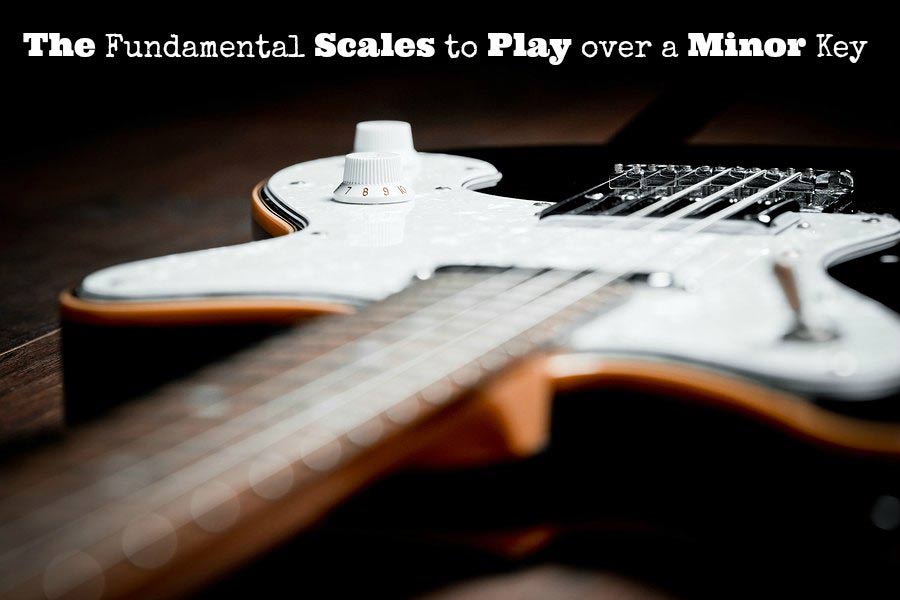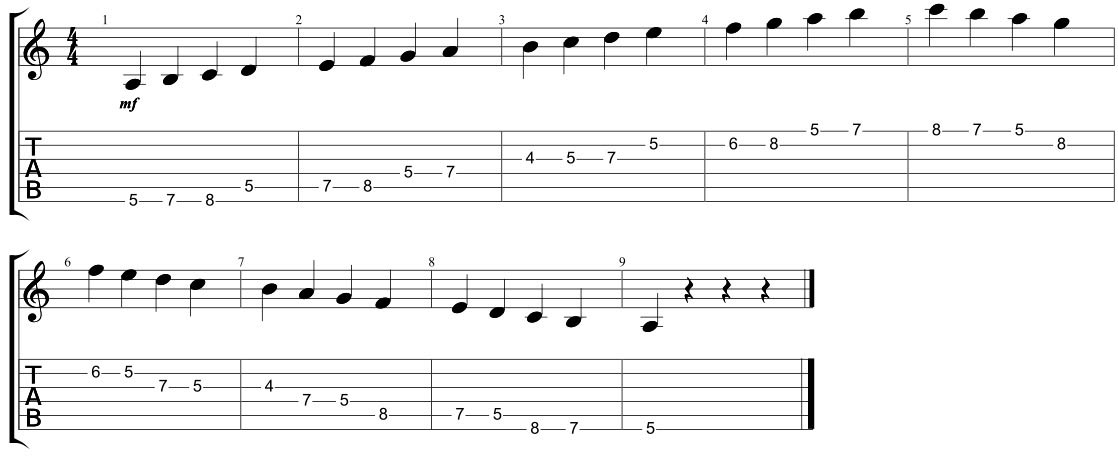March 29, 2021 by Klaus Crow
 According to scientific american it seems that over the last few decades popular music has changed it’s course from major to minor keys.
According to scientific american it seems that over the last few decades popular music has changed it’s course from major to minor keys.
A minor key means the song is in a key or mode based on a minor scale. The song usually has a more darker, melancholic or sad mood.
To be able to improvise over a minor key you need a minor scale. There are a lot different types of minor scales. Today we focus on the most important scales played over a minor key.
The two most used and fundamental scales are the natural minor scale and the minor pentatonic scale.
CHORDS
We can use the chords built from the natural minor scale to play these scales over.
The chord formula for the natural minor scale:
minor – diminished – major – minor – minor – major – major
Often notated as Roman numerals: i – ii – III – iv – v – VI – VII
For example we’re going to play chords in the key of “A” minor.
Apply the notes of the A natural minor scale: A – B – C – D – E – F – G to the chord formula.
You get the following chords: Am – Bdim – C – Dm – Em – F – G
You can use these chords to build any progression. A popular and common chord progression is Am G F G (i – VII – VI – VII)
Here can you learn more on how to build chords and progressions of the minor scale.
THE SCALES
We use scales as a vehicle to improvise over these chords. Both of the scales below are in the key of A, so they fit perfectly over the Am chord progressions.
A Minor Pentatonic Scale

It’s older brother, the blues scale has only one extra note (b5), which adds a lot of value, and leads to six notes: 1 b3 4 b5 5 b7.
For more on minor pentatonic and blues scales check out these posts:
– The Two Most Important Scales in Western Music
– 3 Basic Blues Licks Using The Pentatonic Scale
– The 5 Pentatonic Scale Shapes You Must Know
– Ruthless Minor Pentatonic Scales over 3 Octaves
– 50 Cool Blues Licks Improvisation
A Natural Minor Scale

If you want to dive deeper into the natural minor scale check out these posts:
– Exploring The Natural Minor Scale
– The 5 Natural Minor Scale Positions You Must Know
MORE SCALES
There are plenty more scales to use over a minor key. If you already familiar with the minor pentatonic and the natural minor scale and you want to step up, check out the dorian scale, harmonic minor scale and the melodic minor scale. They set the stage for beautiful exceptional colors and mysterious atmospheres over a minor key.
The scales are mostly used in jazz music, but they can certainly be applied to various styles of pop and rock music as well. Note that the chords used for playing these scales over slightly change as you can learn in the posts below. Dig in:
– Dorian scale: How to Play and Apply The Dorian Scale
– Harmonic minor scale: The Awesome Harmonic Minor Scale
– Melodic minor scale: The Melodic Minor Scale
Have fun!
Hi, :) I having been playing acoustic guitar for a year. Now I gave a thought about trying electric guitar,my budget is 25000 inr. Could you please help me buy a guitar.
Hi Srikumar,
Check out these posts for great recommendations:
https://www.guitarhabits.com/the-best-high-quality-affordable-acoustic-guitars/
https://www.guitarhabits.com/10-best-affordable-acoustic-guitars-under-200-dollars/
Best regards,
Klaus Crow
Hi Klaus, i love this blog. Im a silent reader but been learning a lot from your posts for almost two years now. Thanks a lot!
I have two questions about the minor scale progression.
First: When you wrote
“… minor – diminished – major – minor – minor – major – major
Often notated as Roman numerals: I – ii – iii – IV – V – vi – vii …”
Isn’t the tradition to use Upper Case for mayor chords, and lower case for minor?
Wouldn’t be more accurate to write i – II – III – iv – v – VI – VII ?
Second:
I was searching about minor chord progressions last night and found this chord formula for the natural minor scale:
i – II dim – III – iv – V7 – VI – VII
Is it wrong? is it other minor scale?
Thanks mate, you rock.
Hi Nacho,
You’re right, it’s a typo.
It should be i ii III iv v VI VII (minor – diminished – major – minor – minor – major – major)
A diminished chord is constructed of minor third intervals, so it’s notated as a lowercase.
In the second example:
i ii III iv V7 VI VII
The 5th scale degree is treated as a dominant 7th chord which gives you a perfect cadence when going from the V to the i chord.
A perfect cadence is a progression from V to I in major keys, and V to i in minor keys, where the V is the dominant 7th chord.
The V7 chord has a very strongly pull towards to the tonic, which makes for a perfect cadence.
Both chord sequences are used for a natural minor scale.